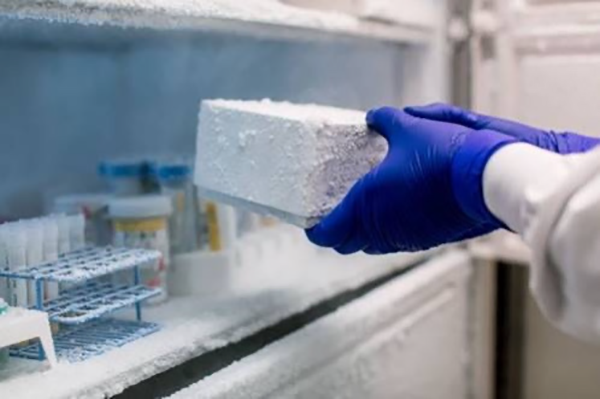A total cost of ownership and Sustainable Health in Procurement Project case study

Name of facility, location
Mayo Clinic
Rochester, Minnesota
Highlights
- The Mayo Clinic had a fleet of over 1,000 lab freezers that use as much energy as about 1,000 homes.
- They standardized purchasing practices for their fleet of ultra-cold lab freezers to buy more energy-efficient models.
- By selecting the most energy-efficient model, rather than the lowest price, they will achieve a 60% energy-use reduction and long-term savings of more than $6 million over 10 years.
Ultra-cold laboratory freezers: Energy efficiency and long-term cost savings of more than $6 million over 10 years.
In laboratories, where freezers are crucial to keep specimens viable for scientific testing and research and to store vaccines, they are big energy users. Mayo Clinic has a fleet of over 1,000 lab freezers that use as much energy as about 1,000 homes annually. Recognizing an opportunity to standardize purchasing and impact energy use, Mayo Clinic decided to replace its fleet of ultra-cold lab freezers with more energy-efficient models. In comparing various models, the selected freezer will reduce energy use by over 60%, contributing to human health and environmental benefits. Taking a “total cost of ownership” approach highlighted the cost savings realized through these efficiencies.
The challenge
A supply chain team member championed the process of transitioning the old ultra-cold freezers to new, more energy-efficient ones. He leveraged his background as a chemist and laboratory experience to explore a unique opportunity – lab freezers. He identified great potential for cost and energy savings by replacing the old models, some purchased as far back as 1979.
Mayo Clinic operates more than 1,000 ultra-cold freezers. These freezers have a high-capital cost (over $10,000 each) and a high cost of maintenance. These freezers also use more energy than other equipment in the labs and require a significant amount of time to maintain. Any unit failure could result in the loss of stored specimens and the loss of decades of research.
The research was conducted, and a team was formed to create an RFP to replace and standardize equipment over time. During this process, one element was clear: assessing the total cost of ownership of the freezers needed to be part of the decision-making process.
Proposed alternatives
The Mayo Clinic team chose an alternative freezer after reviewing their options with several vendors and manufacturers. The team collected data using cost factors, including assessing the total cost of ownership and other protocols, to perform side-by-side evaluations of the freezers. After a full market review, there were a total of four alternatives considered as part of the assessment.
Progress and benefits
Benefits by the numbers: Greenhealth cost of ownership calculator
The Greenhealth cost of ownership calculator compared the energy-efficient ultra-cold lab freezers to traditional ones. The cost of ownership calculation included a comparison: of purchase price, battery costs, and costs associated with energy usage. The total cost of ownership calculation identified that the most energy-efficient model had the lowest cost over 10 years, even though it had a higher purchase price. The savings in energy offset the cost to purchase and the battery replacement cost.



Human health benefits
Each of the old lab freezers used an average-sized home's worth of electricity. On one Mayo Clinic campus, the freezers use as much electricity as about 1,000 homes per year. The new energy-efficient freezers compared to new, less efficient freezers reduce energy use by 60%. Associated environmental health benefits include avoiding over $7 million in community health incidents and costs associated with the energy saved, including direct medical costs, lost wages, and associated health impacts like asthma and respiratory symptoms, based on inputs using Practice Greenhealth and Health Care Without Harm’s Energy and Health Impact Calculator.
Environmental benefits
By selecting Energy Star-rated models that use 60% less energy aligns with Mayo Clinic’s focus to use energy-efficient options whenever possible. The Rochester, Minnesota, campus houses a majority of the freezers to be replaced therefore a focus for energy conservation.
Additionally, the new freezers use more sustainable refrigerants, which do not include ozone-depleting substances and have low global warming potential.
Patient benefits
Updating and standardizing these freezers will reduce Mayo Clinic’s carbon footprint and improve energy efficiency, benefiting patients and communities through environmental improvement.
System benefits
Replacing the freezers had many benefits, including:
- The standardization of equipment and replacement parts assisted maintenance, allowing Mayo Clinic to stock more replacement parts, be better prepared for service calls, and waste less time and money on repairs.
- The new freezer options had a lower total cost of ownership. Additional savings were found by standardizing the purchase of equipment and replacement parts.
- New lab freezers increased the resiliency of the system. The new equipment reduced the risk to the labs' research, contributing to the care being provided at the hospitals and clinics.
- The Greenhealth cost of ownership calculator revealed cost variables that helped the supply chain staff collect data, justify changing the equipment, and inform decision-making. The costs included purchase price, battery costs, and costs associated with energy usage.
- Additional cost of ownership factors that weren’t included in the health system’s assessment but could be relevant are freight, installation, disposal, maintenance/labor, etc. Seventy-eighty percent of all new purchases are being replaced with the preferred Energy Star (a U.S. EPA standard for energy-efficiency) model. A majority of these freezers are located on the Rochester, Minnesota, campus, which is the largest Mayo Clinic campus, resulting in significant energy savings at this location.
- Seventy to eighty percent of new purchases are being replaced with the preferred Energy Star (a U.S. EPA standard for energy-efficiency) model. A majority of these freezers are located on the Rochester, Minnesota, campus, which is the largest Mayo Clinic campus, resulting in significant energy savings at this location.
Implementation process
The most noteworthy factor for change came from employee initiative and leadership support.
- The supply chain staff engaged in a broad review for standardization and increased energy efficiency in the ultra-cold freezers prior to submitting the RFP.
- This review prompted development of a team to replace the freezers. The team consisted of representatives of the supply chain, sustainability, laboratory, and facilities management departments, and high-volume users (researchers and laboratory personnel). The team engaged with suppliers: vendors and manufacturers.
- The team outlined a set of criteria to evaluate the freezers. Side-by-side trials were conducted to help select potential replacement freezers.
- After the testing and evaluation stage was complete, the team drafted a FAQ document summarizing the findings. The development of the FAQ helped create buy-in from the key stakeholders.
Lessons learned
- Not all the freezers could be standardized to the same model. Ten to twenty percent of the freezers were in a location that could not accommodate the new model’s dimensions.
- Some of the locations were wired for 120 volts, but the new freezers required 220 volts.
- Some labs were initially resistant to changing the freezers. Two actions addressed this:
- Creating a diverse team of experts (including high-volume users) to identify mitigation strategies.
- A FAQ document created to address a variety of topics (operational, environmental, and financial) served to lessen concerns.
Next steps
The supply chain department is in year three of a five-year contract and has replaced over 300 freezers. They will continue to implement the changes throughout their system. The freezers are expected to last 10 years but have the potential to last up to 30 years; factors such as energy efficiency, maintenance requirements, and reliability will determine the freezer's lifespan.
Information about the organization
Mayo Clinic is one of the largest nonprofit academic health systems in the United States with $14 billion in annual revenues and 65,000 employees. With a focus on caring for patients with serious, complex illnesses, Mayo operates in five states and cares for more than 1 million people a year, from all 50 states and nearly 140 countries. U.S. News and World Report ranks Mayo Clinic #1 in the nation.
Health Care Without Harm and the United Nations Development Programme (UNDP) acknowledge the funding for this work from Swedish International Development Cooperation Agency. The authors are solely responsible for this document. The views expressed do not represent the official views of SIDA or UNDP.
